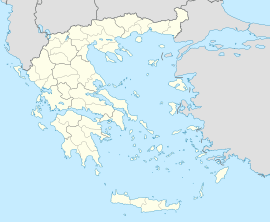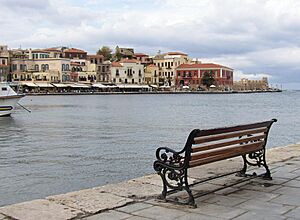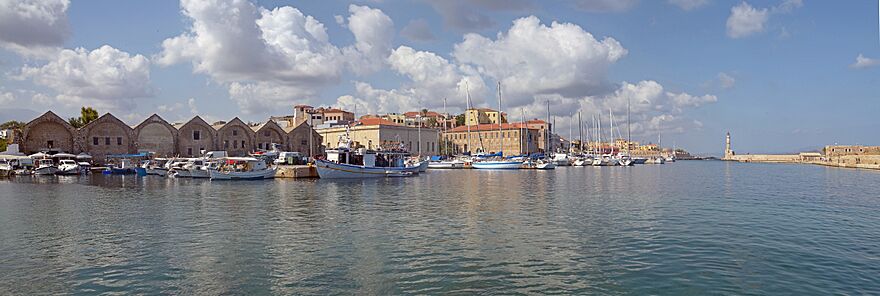Chania facts for kids
Quick facts for kids
Chania or Hania
Χανιά
|
||
|---|---|---|

View of the "Venetian port" of Chania.
|
||
|
||
| Country | Greece | |
| Administrative region | Crete | |
| Regional unit | Chania | |
| Area | ||
| • Municipality | 351.3 km2 (135.6 sq mi) | |
| Elevation | 20 m (70 ft) | |
| Population
(2021)
|
||
| • Municipality | 111,375 | |
| • Municipality density | 317.04/km2 (821.12/sq mi) | |
| • Municipal unit | 54,559 | |
| Demonym(s) | Chanian, Chaniotis/Haniotis, Chaniotisa/Haniotisa | |
| Time zone | UTC+2 (EET) | |
| • Summer (DST) | UTC+3 (EEST) | |
| Postal code |
73100
|
|
| Area code(s) | 28210 | |
| Vehicle registration | ΧΝ | |
| Website | www.chania.gr | |
Chania (pronounced Kha-nyah) is a beautiful city in Greece. It is the capital of the Chania region on the island of Crete. You can find it on the northwest coast of Crete, about 70 kilometers (43 miles) west of Rethymno.
The city of Chania and its nearby areas have about 111,375 people living there (as of 2021). Some of these nearby areas include Kounoupidiana, Mournies, and Souda.
Contents
Chania's Long History
Chania has a very old and interesting past, going back thousands of years!
Ancient Times: Minoans, Greeks, and Romans
Chania was once a settlement of the Minoan civilization. This ancient city was called Ku-do-ni-ja, which later became Cydonia in Greek. Archaeologists have found proof of this Minoan city under parts of today's Chania. People have lived in this area since the Stone Age!
After the Minoan period, Cydonia became an important city-state in Classical Greece. Around 1100 BC, people called the Dorians came from mainland Greece and settled here. Cydonia often fought with other cities on Crete. The famous Greek writer Homer even mentioned Cydonia in his story, the Odyssey.
Later, in 69 BC, the Romans took over Cydonia. However, they still allowed it to be an independent city.
Middle Ages: Byzantines and Arabs
For many years, Chania was ruled by the Byzantine Empire. This was from 395 AD to 824 AD. Then, Arab invaders took control and called the settlement al-Khan. This name might have come from an old word for a guesthouse or inn.
By the time the Byzantines ruled again (961–1204), the city was known as Chania in Greek. To protect it from more invasions, the Byzantines built strong walls around the city. They even used stones from older buildings to make them!
Venetian Rule: La Canea Flourishes
After the Fourth Crusade in 1204, the island of Crete was sold to the Venetians. In 1252, the Venetians took control of Chania. They called the city La Canea.
Under Venetian rule, Chania became a very important trading center. The Venetians built strong fortifications around the city, which you can still see parts of today. Over time, the cultures of Crete and Venice mixed, but the people of Crete kept their Greek Orthodox faith. Many important buildings were built during this time, and people enjoyed learning and arts.
Ottoman Rule: Changes and Conflicts
In 1645, the Ottomans captured Chania from the Venetians after a long fight. Many people left, and some were forced to change their religion. Many Turkish Muslim settlers moved in, changing the city's population.
Under the Ottoman name Hanya, Muslims mainly lived in the eastern parts of the city. They turned the Church of St Nicholas into a mosque and built new ones, like the Küçük Hasan Pasha Mosque by the harbor. The city also got public baths and fountains.
Chania stayed under Ottoman control for a long time, even during the Greek War of Independence. Because both Muslims and Christians lived on Crete, there were often disagreements. Eventually, many Muslims moved away from the island, and the last ones left in 1922.
Modern Chania: Independence and Growth

In 1898, Chania became the capital of the semi-independent Cretan State. This was a step towards Crete joining Greece. During this time, Crete even had its own stamps and money! The city became more open to the world, mixing European and Eastern cultures. Many beautiful buildings were built, and new social groups emerged. The Halepa district has many old embassies from this time.
A famous politician named Eleftherios Venizelos (who was born near Chania) played a big role in uniting Crete with Greece. After some conflicts, Crete finally joined Greece on December 1, 1913. The Greek flag was raised for the first time at Fort Firka in the Old Harbour.
World War II and After
During World War II, German forces invaded and occupied Chania in 1941. The city was bombed, and many people were harmed or imprisoned for resisting the German rule. The Jewish community of Chania was also sadly taken away by the Germans.
After the war, Chania slowly recovered. In the 1970s, Crete became a popular place for tourists. This helped the city's economy grow a lot. In 1971, the capital of Crete moved to Heraklion.
Since the 1990s, Chania has continued to develop. New buildings, an airport, and a port have made it a popular tourist spot in the Mediterranean Sea.
Exploring Chania's Geography
Chania is located about 40 kilometers (25 miles) from the western end of Crete.
City Layout: Old Town vs. Modern City
Chania has two main parts: the old town and the modern city. The old town is right by the old harbor. It used to be surrounded by strong Venetian walls built in 1538. Only parts of these walls remain today. The modern city is much larger and spreads out from the old town.
The Charming Old Town
The Old Town is where all the different civilizations of Chania began. The very center is called Kasteli, and people have lived there since ancient times. It's on a small hill near the sea, which was a great spot for a settlement.
The main square of the Old Town is Eleftherios Venizelos Square, also called Syntrivani. This is a busy place for tourists. Next to it is the Topanas district, which was the Christian area during Ottoman times. The Jewish quarter was also in this part of the Old Town. Topanas has many narrow streets and old buildings that are now hotels, restaurants, and shops. It's a popular place, especially in summer.
The harbor area is also a special part of the Old Town. You'll find many historic buildings and lively nightlife there. Halidon Street connects the modern city to the old town.
The Modern City
Most people in Chania live and work in the modern part of the city. It's not as old as the Old Town, but it still has interesting areas.
Nea Hora, meaning "New Town," is the oldest district of the modern city. It has narrow old streets leading to a small fishing harbor. Koum Kapi, on the east side of the old town, was also one of the first areas built outside the walls. It's now a lively area with cafes and restaurants by the beach.
The Halepa district, to the east, used to be home to wealthy families. Some old buildings there are being restored. Important buildings in Halepa include Eleftherios Venizelos's House and the old French school. Part of Halepa called Tabakaria has unique old leather processing houses.
New neighborhoods have grown throughout the 20th century. While some parts of the city center have modern block buildings, you can still find beautiful neoclassical houses.
Chania has parks and sports grounds, like the Venizeleio Stadium. The 1913 indoor market, called "Agora," is popular with everyone. Other important modern sites include the Court House, the Public Gardens, and the Cultural Centre. Many residents are now moving to the suburbs, especially around Kounoupidiana.
Chania's Climate
| Weather chart for Chania, Greece | |||||||||||||||||||||||||||||||||||||||||||||||
|---|---|---|---|---|---|---|---|---|---|---|---|---|---|---|---|---|---|---|---|---|---|---|---|---|---|---|---|---|---|---|---|---|---|---|---|---|---|---|---|---|---|---|---|---|---|---|---|
| J | F | M | A | M | J | J | A | S | O | N | D | ||||||||||||||||||||||||||||||||||||
|
142
14
8
|
112
15
8
|
81
17
9
|
32
20
11
|
13
24
15
|
4.6
29
19
|
1.3
30
21
|
1.6
30
21
|
19
27
18
|
80
23
15
|
73
20
12
|
94
16
9
|
||||||||||||||||||||||||||||||||||||
| temperatures in °C precipitation totals in mm |
|||||||||||||||||||||||||||||||||||||||||||||||
|
Imperial conversion
|
|||||||||||||||||||||||||||||||||||||||||||||||
Chania has a Mediterranean climate. This means it has sunny, dry summers and mild, rainy winters. From April to October, the weather is usually clear and warm. Strong heat waves are not very common because of cool winds from the Aegean Sea.
Even in winter, there are often sunny days. Snow and frost are rare near the coast. However, there was a big snowstorm in February 2004 and again in January 2017. The temperature can sometimes drop below freezing or reach very high temperatures in summer. The highest temperature recorded was 44.3 °C (111.7 °F) in July 2021.
The climate in Chania can change depending on the area and how high it is above sea level. The White Mountains are to the south, and different winds also affect the weather.
| Climate data for Chania Airport (Souda) 1971–2000 | |||||||||||||
|---|---|---|---|---|---|---|---|---|---|---|---|---|---|
| Month | Jan | Feb | Mar | Apr | May | Jun | Jul | Aug | Sep | Oct | Nov | Dec | Year |
| Mean daily maximum °C (°F) | 14.0 (57.2) |
14.3 (57.7) |
16.1 (61.0) |
19.9 (67.8) |
24.5 (76.1) |
29.0 (84.2) |
30.5 (86.9) |
30.0 (86.0) |
27.5 (81.5) |
23.4 (74.1) |
19.0 (66.2) |
15.6 (60.1) |
22.0 (71.6) |
| Daily mean °C (°F) | 10.8 (51.4) |
11.0 (51.8) |
12.4 (54.3) |
15.8 (60.4) |
20.1 (68.2) |
24.7 (76.5) |
26.6 (79.9) |
25.9 (78.6) |
23.2 (73.8) |
19.4 (66.9) |
15.3 (59.5) |
12.4 (54.3) |
18.1 (64.6) |
| Mean daily minimum °C (°F) | 8.1 (46.6) |
8.0 (46.4) |
8.9 (48.0) |
11.7 (53.1) |
15.2 (59.4) |
19.2 (66.6) |
21.4 (70.5) |
21.3 (70.3) |
19.1 (66.4) |
15.9 (60.6) |
12.4 (54.3) |
9.7 (49.5) |
14.2 (57.6) |
| Average rainfall mm (inches) | 126.4 (4.98) |
101.9 (4.01) |
81.2 (3.20) |
26.9 (1.06) |
11.2 (0.44) |
2.0 (0.08) |
1.4 (0.06) |
1.4 (0.06) |
15.2 (0.60) |
61.5 (2.42) |
86.7 (3.41) |
98.9 (3.89) |
614.7 (24.21) |
| Average rainy days (≥ 0.1 mm) | 17.0 | 14.7 | 12.0 | 7.8 | 3.9 | 1.4 | 0.2 | 0.6 | 2.6 | 9.8 | 10.8 | 15.8 | 96.6 |
| Mean monthly sunshine hours | 118.1 | 135.6 | 188.0 | 240.9 | 303.0 | 355.4 | 376.7 | 355.7 | 281.9 | 208.7 | 138.0 | 111.7 | 2,813.7 |
| Source: Climate Atlas-Hellenic National Meteorological Service. | |||||||||||||
Chania's Culture and Arts
Chania has many museums, art galleries, and music groups. It also has places for education and research.
Some of the most important museums in Chania are:
- Chania's new Archaeological Museum: This museum has many old items found in the region from different time periods.
- Folklore Museum (in the Old Town)
- Historical Archive (one of the most important in Greece)
- Nautical Museum of Crete (in the Old Town)
- Municipal Art Gallery
- House of Eleftherios Venizelos
- Museum of Chemistry
- School life museum
- Museum of Typography, Chania
Several theater groups perform in Chania, including the Municipal and Regional Theatre of Crete. They put on both old and new plays. The Venizelian Conservatory of Music is also a very important cultural group. There's even a chamber music group called "Sinfonietta." Chania also has many musicians who play alternative, indie, and jazz music, as well as traditional Cretan music.
The city has five cinemas, two of which are open-air. They show both popular and independent movies.
You'll find many cafes, restaurants, and bars in the Old Town, especially around the old Venetian harbor. During summer, there are many cultural events every day, like plays, concerts, and art shows. The Municipal Cultural Corporation of Chania helps organize many of these events.
Sports in Chania
Water sports are very popular in Chania. The local water polo team, Nautical Club of Chania (N.O.X.), is one of the best in Greece. Many players from this team have also played for the Greek national team.
Football and basketball are also popular. The main football team is Chania FC. Another team, Platanias FC, used to play in Greece's top league.
For athletics, the main clubs are "Eleftherios Venizelos" and "Kydon." The "Antisfairisi" club is known for tennis, table tennis, and chess. Many sports are played at the old Stadium of Chania, which was built in 1935.
There's an outdoor swimming pool for water sports in Nea Chora. A new indoor pool was built in 2006 but isn't open yet. A modern indoor stadium for basketball and volleyball, called Chania Kladissos Indoor Hall, was built in 2005.
Chania also has an active climbing and hiking club that organizes trips to the mountains of Crete and other places.
Education and Research
Chania has several important educational places:
- Technical University of Crete
- The Chania branch of the Technological Educational Institute of Crete
- The Mediterranean Agronomic Institute of Chania
- The Merchant Marine Academy of Crete
Other research groups and societies in Chania include:
- The National Research Foundation "Eleftherios K. Venizelos"
- The Mediterranean Architecture Centre (KAM)
- The Institute of Olive Tree and Subtropical Plants of Chania
- The Institute of Cretan Law
Most schools in Chania are public. However, some private high schools have started to appear recently.
Chania's Economy
The two main ways people in Chania earn money are through agriculture (farming) and tourism. Many people own farmland where they grow olive trees and citrus fruits. Other important products include wine, avocados, and dairy products. There are events like "Agricultural August" to promote local products.
Tourism has grown very quickly since the 1970s. More and more locals are now working in businesses related to tourism.
The Chania Chamber of Commerce and Industry helps with economic activities in the city. Recently, the prices for luxury homes in Chania have gone up a lot, showing that more wealthy tourists and people from other countries want to live there. This helps both tourism and real estate.
Getting Around Chania
Chania has good transportation links:
- Airport: Chania International Airport (CHQ) is 14 km (9 miles) from the city. It's named after Daskalogiannis, a local hero.
- Port: Souda, about 7 km (4 miles) east of Chania, is the city's port. You can take daily ferries from here to Piraeus (near Athens). Souda also has a big Greek and NATO naval base.
- Motorway: The A90 motorway runs along the north coast of Crete. It connects Chania to other cities like Kissamos and Heraklion.
Famous People from Chania
Many notable people have connections to Chania:
- Eleftherios Venizelos (1864–1936): A very important prime minister of Greece.
- Constantine Mitsotakis (1918–2017): A former prime minister of Greece.
- Mikis Theodorakis (1925–2021): A famous Greek composer.
- Nana Mouskouri (1934–): A well-known Greek singer.
- John Aniston (1933–2022): An actor and father of Jennifer Aniston.
- Apostolos Papastamos (2001–): A Greek Olympic swimmer.
Chania's Sister Cities
Chania is twinned with several cities around the world:
 Engomi, Cyprus
Engomi, Cyprus Famagusta, Cyprus
Famagusta, Cyprus Paphos, Cyprus
Paphos, Cyprus Polis, Cyprus
Polis, Cyprus Axioupoli, Greece
Axioupoli, Greece Ermoupoli, Greece
Ermoupoli, Greece Karpathos, Greece
Karpathos, Greece Wellington, New Zealand
Wellington, New Zealand
Images for kids
-
Statue of Francis of Assisi outside the Catholic church of Chania
See also
 In Spanish: La Canea para niños
In Spanish: La Canea para niños




































